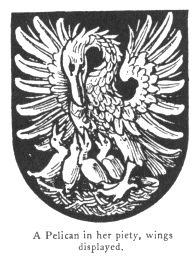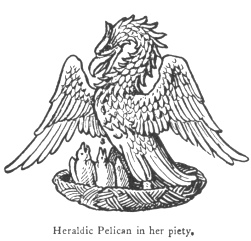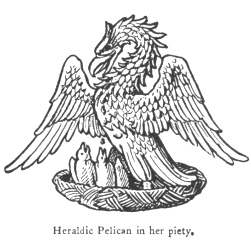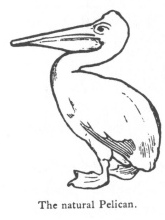
Masonic, Occult and Esoteric Online Library
Fictitious and Symbolic Creatures in Art
By John Vinycomb
Other Chimerical Creatures and Heraldic Beasts- The Heraldic Pelican
"Then sayd the pellycane
When my byrats be slayne
With my bloude I them reuyue (revive)
Scrypture doth record,
The same dyd our Lord,
And rose from deth to lyue."
Skelton, "Armory of Birds."
The character ascribed to the pelican is nearly as fabulous as that of the phœnix. From a clumsy, 
gluttonous, piscivorous water-bird, it was by the growth of legends transformed into a mystic emblem of Christ, whom Dante terms "Nostro Pelicano." St. Hieronymus gives the story of the pelican restoring its young ones destroyed by serpents as an illustration of the destruction of man by the old Serpent, and his salvation by the blood of Christ.
The Pelican in Christian Art is an emblem of Jesus Christ, by "whose blood we are healed." It is also a symbol of charity.
The "Bestiarum" says that Physiologus tells us that the pelican is very fond of its brood, but when the young ones begin to grow they rebel against the male bird and provoke his anger, so that he kills them; the mother returns to the nest in three days,

sits on the dead birds, pours tier blood over them, and they feed on the blood.
Heralds usually represent this bird with wings endorsed and neck embowed, wounding her breast with her beak. Very many early painters mistakenly represented it similar to an eagle, and not as a natural pelican, which has an enormous bag attached to the lower mandible, and extending almost from the point of the bill to the throat. When in her nest feeding her young with her blood, she is said to be in her piety.
The Romans called filial love piety, hence Virgil's hero is called the "pious Æneas," because he rescued his father from the flames of Troy.
The myth that pelicans feed their young with their

blood arose from the following habit, on which the whole superstructure of fable has been erected: They have a large bag attached to their under-bill. When the parent bird is about to feed its brood, it macerates small fish in this bag or pouch; then, pressing the bag against its breast, transfers the macerated food to the mouths of the young ones.
The pelican in her piety is not an uncommon symbol upon monumental brasses. That of William Prestwick, Dean of Hastings, in Warbleton Church, Sussex, has it with the explanatory motto: "Sic Xtus dilexit nos."
Examples.—Gules, a pelican in her piety, or.—Chauntrell.
Azure, three pelicans argent, vulning themselves proper.—Pelham, Somerset, &c.
A pelican's head erased, or otherwise detached from the body, must always be drawn in the same position and vulning itself. It should always be separated as low as the upper part of the breast.
It is said naturalists of old, observing that the pelican had a crimson stain on the tip of its beak, reported that it was accustomed to feed its young with the blood flowing from its breast, which it tore for the purpose. In this belief the Early Christians adopted the pelican to figure Christ, and set forth the redemption through His blood, which was willingly shed for us His children.
Alphonso The Wise, King of Castile (+ 1252). A pelican in its piety. Motto: "Pro lege et grege."
William of Nassau, founder of the Republic of the United Provinces, one of the noblest characters of modern history. He bore on some of his standards the pelican, and on others the motto: "Pro lege, grege et rege."
Pope Clement IX. One of his devices was the pelican in its piety. Motto: "Aliis non sibi 
clemens" ("Tender-hearted to others, not himself").
Other mottoes for the pelican:
"Ut vitam habeant" ("That they may have life").
"Immemor ipse sui" ("Unmindful herself of herself").
"Mortuos vivificat" ("Makes the dead live").
"Nec sibi parcit" ("Nor spares herself").
